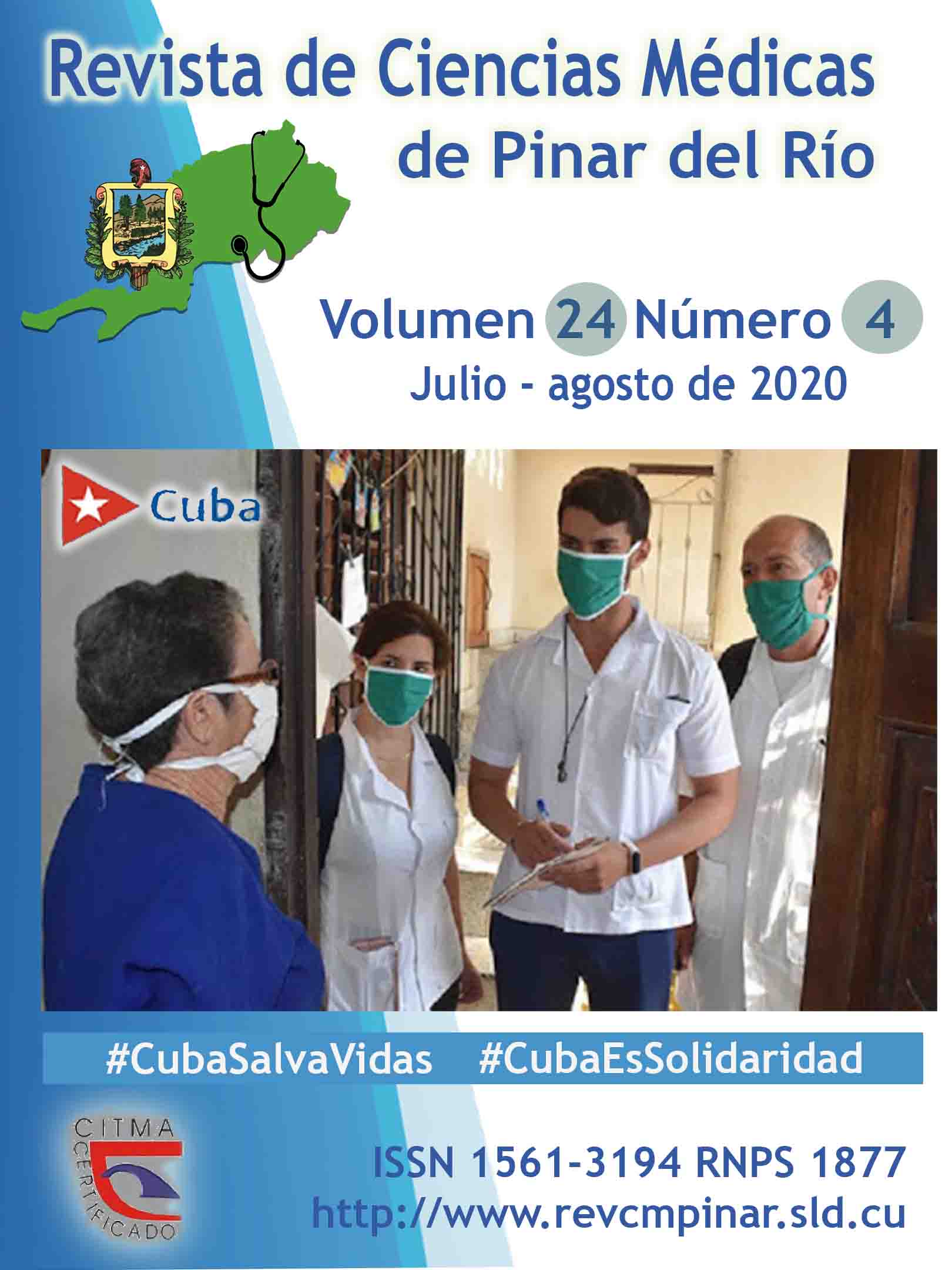Non-organic nocturnal enuresis treated with homeopathic drugs
Keywords:
CHILD, ENURESIS, HOMEOPATHIC REMEDY.Abstract
Introduction: nocturnal enuresis in children is a frequent reason for attending the doctor’s office.
Objective: to evaluate the clinical evolution in pediatric patients from 5 to 18 years old with non-organic nocturnal enuresis treated with homeopathic drugs.
Methods: a quasi-experimental intervention study was conducted. The sample intentionally comprised 327 patients with nocturnal enuresis from the Homeopathy Clinic at Pepe Portilla Provincial Pediatric Teaching Hospital, from January 2015 to January 2018. Descriptive tools such as frequency tables and percentage calculation were applied to process the data. In addition to the Kolmogorov Smirnov test to compare the trend of the variables between two independent groups.
Results: male children between 5 and 11 years old predominated. In both groups, primary enuresis, the characteristic inability to wake up and family history of enuresis prevailed. In the study group, 76.1% had complete response to treatment, only one case had no response, in the control group only 8.3% of patients had complete response.
Conclusions: homeopathy is a useful therapeutic modality in the treatment of non-organic nocturnal enuresis in children.
Downloads
References
1. Rojas Carrion KG, Izquieta Quezada JS. Etiología de la enuresis en niñez intermedia. Colección. Repositorio digital de la Utmachala. Examen Complexivo Psicología Clínica [Internet] 2019. [citado 14/04/2019]. Disponible en: http://repositorio.utmachala.edu.ec/handle/48000/13886
2. Romero Berendt S. “El dinosaurio de porcelana y su volcán: la historia de un reino y el asesinato de su Rey”: El Complejo de Edipo en un niño de 6 años, manifestado a través del erotismo anal y uretral. Estudio de un caso clínico [tesis]. Maestría en profundización clínica psicodinámica. Bogotá (Colombia): Norte; 2017 [Citado 14/04/2019]. Disponible en: http://manglar.uninorte.edu.co/bitstream/handle/10584/7856/130887.pdf?sequence=1&isAllowed=y
3. Saieh AC, Álvarez SC, Lucero AY. Enuresis en niños: frecuencia y antecedentes familiares. rev. med. clin. Condes [Internet]. 2015 [citado 05/09/2016]; 26(1):[aprox 5p.]. Disponible en: https://es.scribd.com/document/288123412/ENURESIS-EN-NIN-OS-FRECUENCIA-Y-ANTECEDENTES-FAMILIARES
4. Meave Cueva LG, Díaz García L, Garza Elizondo R. Diagnóstico y tratamiento de la enuresis no orgánica en pacientes pediátricos. Acta Pediátr Mex [Internet]. 2014 [citado 09/01/2015]; 35: [aprox 6p.]. Disponible en: http://www.medigraphic.com/pdfs/actpedmex/apm-2014/apm141d.pdf
5. Gutiérrez Abad C, San José Calleja MN, Castroviejo Espinosa M, Sánchez Gutiérrez R, Ardela Díez E, Cordero Guevara JA. Enuresis nocturna: estudio epidemiológico en población escolar. Rev Pediatr Aten Primaria [Internet]. 2015 Sep [citado 14/04/2019]; 17(67): [aprox. 7p.]. Disponible en: http://scielo.isciii.es/scielo.php?script=sci_arttext&pid=S1139-76322015000400004&lng=es
6. Úbeda Sansano MI, Martínez García R. ¿Y qué hacemos si aún moja la cama? En AEPap ed. Curso de Actualización Pediatría 2015. [Internet]. Madrid: Lúa Ediciones 3.0; 2015. [Citado 14/04/2019]: [aprox. 13p.]. Disponible en: https://www.aepap.org/sites/default/files/cursoaepap2015p305-318.pdf
7. Rojas Carrion KG, Izquieta Quezada JS. Etiología de la enuresis en niñez intermedia. Colección. Repositorio digital de la Utmachala. Examen Complexivo Psicología Clínica [Internet]. 2019 [citado 14/04/2019]. Disponible en: http://repositorio.utmachala.edu.ec/handle/48000/13886
8. Caldwell PHY, Sureshkumar P, Wong WCF. Fármacos tricíclicos y fármacos relacionadas para el tratamiento de la enuresis nocturna en los niños. Cochrane Database of Systematic Reviews [Internet]. 2016 [citado 14/04/2019]; (1). Disponible en: https://www.cochrane.org/es/CD002117/farmacos-triciclicos-y-farmacos-relacionadas-para-el-tratamiento-de-la-enuresis-nocturna-en-los
9. Salazar-Ozuna WA, Aragón-Castro MA, Vázquez-Niño CL, Ruvalcaba-Oceguera G, Gutiérrez-Rosales R, Téllez-Díaz Trujillo JA. Tratamiento médico de la enuresis en niños: aspectos actuales. Rev Mex Urol [Internet] 2017 mayo [citado 14/04/2019]; 77(3): [aprox. 7p.]. Disponible en: http://www.medigraphic.com/pdfs/uro/ur-2017/ur173j.pdf
10. Rustoyburu CA. Pediatría psicosomática y medicalización de la infancia en Buenos Aires, 1940-1970. História, Ciências, Saúde [Internet]. 2015 out-dez [citado 14/06/2017]; 22(4): [aprox 17p.]. Disponible en: http://www.scielo.br/pdf/hcsm/v22n4/0104-5970-hcsm-22-4-1249.pdf
11. Martínez Almodóvar MB, López Triana AE, Díaz Montesinos A, Teseiro Plá M. Violencia intrafamiliar y trastornos psicológicos en niños y adolescentes del área de salud de Versalles, Matanzas. Rev. Med. Electrón [Internet]. 2015 Jun [citado 15/06/2017]; 37(3): [aprox. 8p.]. Disponible en: http://scielo.sld.cu/scielo.php?script=sci_arttext&pid=S1684-18242015000300006&lng=es
12. Von Gontard A. ENURESIS [Internet]. Alemania: Universitario Saarland, Hamburgo; 2016 [citado 15/07/2015]. Disponible en: https://iacapap.org/content/uploads/C.4-ENURESIS-SPANISH-2016.pdf
13. Santiago Martínez M. Autonomía y cuerpo objetivado en grandes instituciones: Dispositivos de interiorización del control esfinteriano infantil y su externalización sobrevenida en la decrepitud. Papeles de Trabajo sobre Cultura, Educación y Desarrollo Humano [Internet]. 2014 [citado 15/07/2015]; 10(4): [aprox. 23p.]. Disponible en: http://academica-e.unavarra.es/bitstream/handle/2454/19838/Papeles.pdf?sequence=1
14. Hernández García SH. Opciones terapéuticas de medicina bioenergética natural en Pediatría. Editorial Académica Española; 2016. p.179.
15. Honatur [Internet]. Homeopatía Online; 2017 [actualizado 2017; Citado 15/06/2017]. Disponible en: http://honatur.com/enuresis/
Downloads
Published
How to Cite
Issue
Section
License
Authors who have publications with this journal agree to the following terms: Authors will retain their copyrights and grant the journal the right of first publication of their work, which will be publication of their work, which will be simultaneously subject to the Creative Commons Attribution License (CC-BY-NC 4.0) that allows third parties to share the work as long as its author and first publication in this journal are indicated.
Authors may adopt other non-exclusive license agreements for distribution of the published version of the work (e.g.: deposit it in an institutional telematic archive or publish it in a volume). Likewise, and according to the recommendations of the Medical Sciences Editorial (ECIMED), authors must declare in each article their contribution according to the CRediT taxonomy (contributor roles). This taxonomy includes 14 roles, which can be used to represent the tasks typically performed by contributors in scientific academic production. It should be consulted in monograph) whenever initial publication in this journal is indicated. Authors are allowed and encouraged to disseminate their work through the Internet (e.g., in institutional telematic archives or on their web page) before and during the submission process, which may produce interesting exchanges and increase citations of the published work. (See The effect of open access). https://casrai.org/credit/



